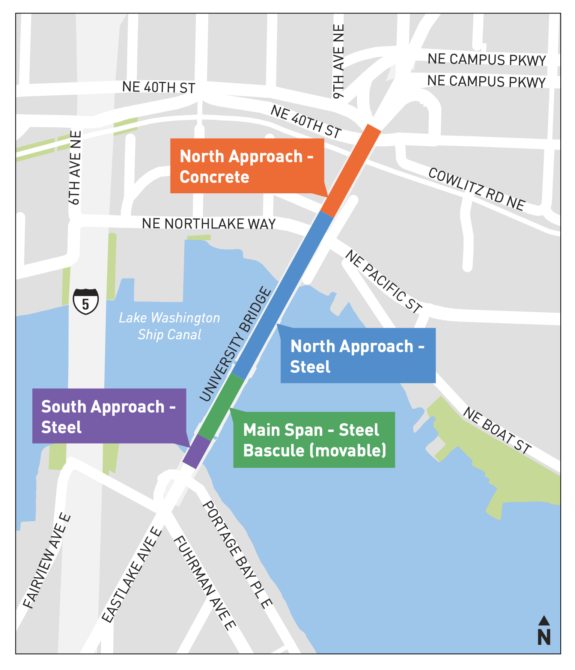
Most of the University Bridge is in decent condition, but the northernmost section between NE 40th and NE Pacific Streets needs major rehab or replacement, according to SDOT. The 1930s concrete structure is at the end of its life, and that may be for the best because it no longer fits into the U District of today.
SDOT is currently conducting an online survey for the project, and you should definitely complete it. In the further thoughts box, I wrote, “Remove highway-style interchanges and connect southbound and northbound bike lanes to the Burke-Gilman Trail.”
The city currently only has funding to begin a study of the bridge replacement and rehab options. Funding for work will need to come from either grants or perhaps the city’s yet-to-be-created 2024 transportation funding package.
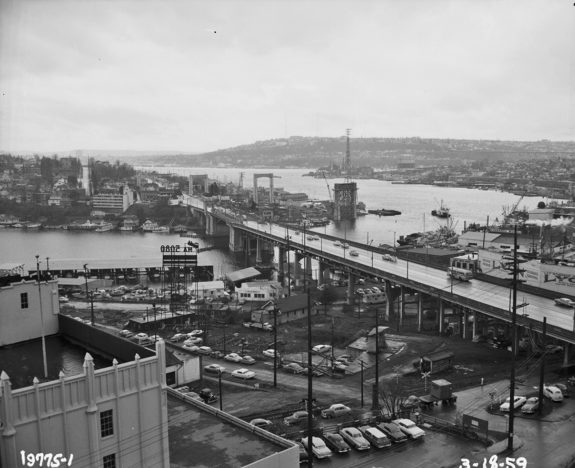
Considering the early stage and undetermined funding source for the work, I would push the city to expand the project scope to also include the area directly north of the bridge structure itself. Remember that these bridge and road connections were designed when there were some major differences compared to today. For example, I-5 did not yet exist, so Roosevelt and 11th were intended to be a north-south backbone roadway for the whole region in a way that simply is not relevant anymore. Another huge difference is that what is now the Burke-Gilman Trail was still an active railroad back then. Because of this, the whole area was designed under the assumption that people would need to avoid what is now a major regional biking and walking trail. The city should be working to build seamless and intuitive connections between the bridge and the trail for people heading in all directions. This project may be the best possible opportunity to rebuild this infrastructure in a way that makes sense for today’s U District.
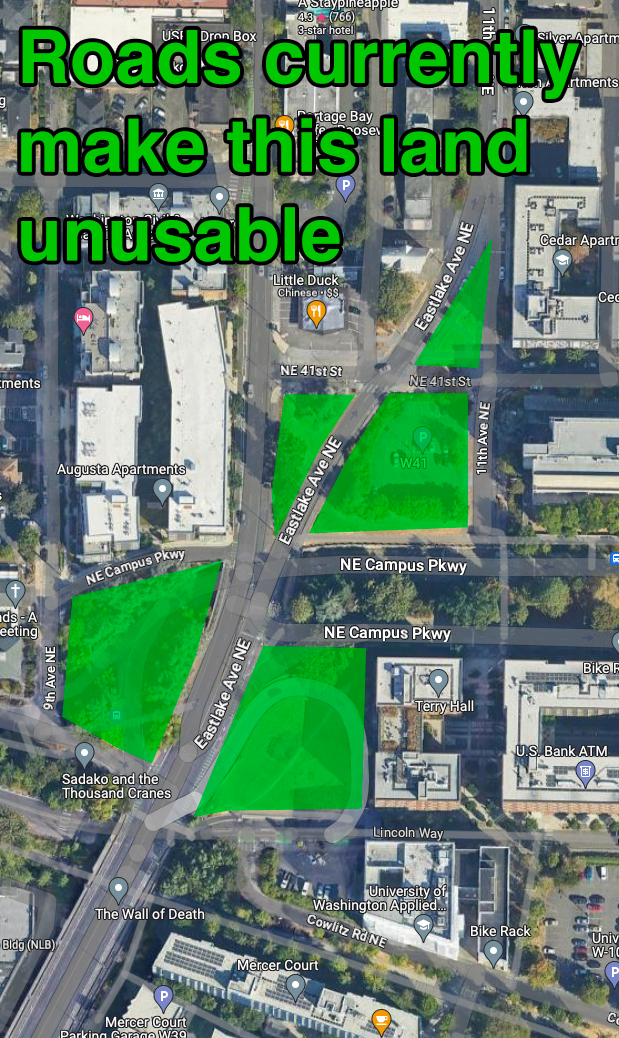
The area just north of the bridge is also the root of a lot of the U District’s traffic, walkability and bikeability problems. The freeway-style quarter-cloverleaf down to 40th has got to go. This is one of the most densely-populated areas in the whole state of Washington, an a freeway cloverleaf has no business being here. There should probably be either housing or a park in that space instead. The gradually-curving road connection to 11th Ave NE is also completely out of place in this densely-populated area. The way it is designed also makes most of a city block completely unusable, leaving behind an awkward triangle of land on one side and a strange lot on the other that is not good for much more than a few parking spaces. We need a radical change to how northbound traffic works here. Let’s use this opportunity to get some creative and visionary ideas on the table.
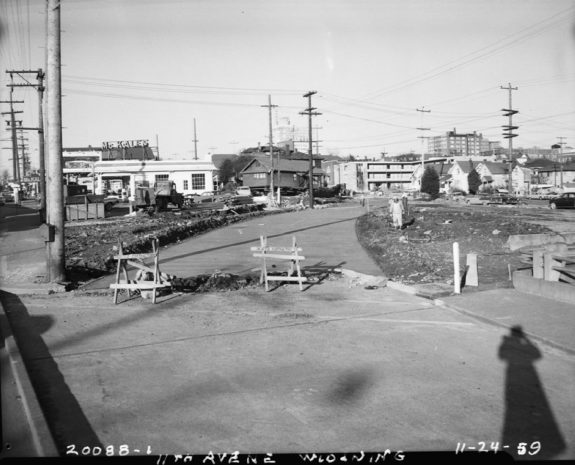
Other questions we can ask: Do we still need westbound Campus Parkway to pass under the roadway? It could just stay at ground level like the eastbound lane and then meet Roosevelt/Eastlake at a traffic signal. That would free up an entire parcel of land on the west side of Roosevelt. The current looping under route is well-used by buses, but it also isn’t all that fast due to the often slow merge on the bridge. I suspect turning left at a traffic signal could be just as fast for buses.
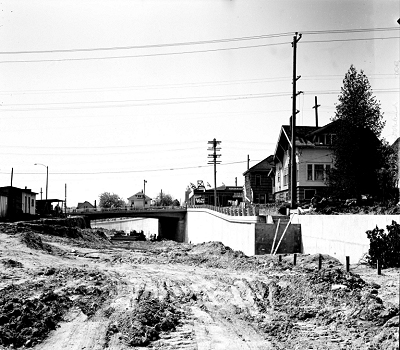
Getting rid of the Campus Parkway trench could also open up left turns onto 11th Ave NE, which is not a high-traffic street even though it looks like one. It would also improve accessibility by removing the need to climb stairs up to the 11th Ave NE sidewalk. The 2020 Seattle Traffic Report (which uses 2019 data, our final pre-pandemic data) shows that 11th only carried 8,500 vehicles per day south of NE 45th Street and a minuscule 5,900 vehicles per day north of 45th. These counts include people on bicycles (assuming the counter tubes are set up properly). That means 11th carries about 60% as many vehicles as Roosevelt Way NE, its one-way couplet. Yet 11th is designed as a highway-style, double-lane road slicing a curve across the street grid so that people driving do not need to slow down. The city’s recent Vision Zero program assessment showed that 80% of people killed by someone driving are struck on a road with multiple lanes in the same direction.
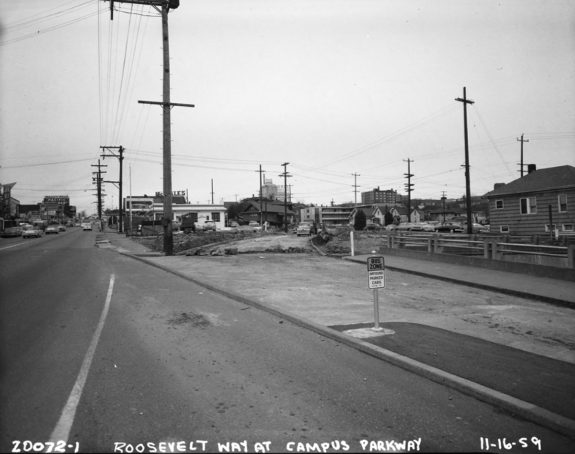
And I would be remiss if I left out my favorite solution: Make Roosevelt Way two-way again. These one-way couplets were a mistake, and they absolutely ruin walkability and bikeability in the neighborhood (I use them every day with my kid and have tried every imaginable route and they are all terrible). 11th in particular is a failure of a street by every measure. Even people driving don’t find it very useful, which is why so few people use it. There are very few commercial properties on 11th because nearly all of them are on Roosevelt instead. 11th should be a regular neighborhood street, not a multi-lane roadway. Such a setup would be better both for residents and for Roosevelt Way businesses.
Though the scale of work I’m describing here is clearly much larger than simply replacing a bridge, is also opens up significant new revenue through the leasing or selling of these new lots for development. Our city needs as much housing as we can get in this area, which is well-served by transit. We also need to update our infrastructure to prioritize walking, biking and transit. This could be an opportunity to accomplish both goals at the same time. And hey, it could make for a fantastic vision to help sell the 2024 Seattle transportation measure to voters.







Comments
10 responses to “North U Bridge project is a huge opportunity for a safer and better-connected U District + Survey”
I rode through that connection from BGT west bound to bridge. For sure it is not well connected. I hope we will see some repurposed land use, road diets and bike/pedestrian priority. If it is not a priority her, where then would it be.
Two-way Roosevelt would be a nice long-term goal!
If we’re talking about this level of transformation, I think Campus Parkway itself is due for a re-design. It has this big median that nobody actually uses because it’s stuck in the middle of a road (most road medians are equally useless), and two very wide lanes per-direction carrying what can’t be a high volume of traffic. It’s a major street for bus transfers but its extreme width makes some transfers harder and more time-consuming, in addition to lengthening traffic signal cycles. Including the median this is a street that’s well over 100′ curb-to-curb — compare 3rd Ave downtown, which achieves much more at about 50′.
So I think what I’d propose is to make the southern half of Campus Parkway into a normal-width two-way street, more like Stevens Way in the main part of campus. It would need a north sidewalk, of course. Then the whole north half of the street could be replaced with extensions of the median’s green space and public plazas — now situated where people can actually use them! The end result wouldn’t quite be like the older main campus area because there would be more streets cutting through the pedestrian spaces but it would be closer to that.
I love this idea.
I hark back to a crosscut article on why Seattle can never be a Dutch or Danish bicycle city. The conclusion, “rain and hills”. What is really left out of the conclusion is in these countries bicycle infrastructure is complete and not leading the bike riding sheep to terrible places to be on a bike. However, another mis understood difference is that many places in the world like Holland and Denmark work to encourage bicycle use while at the same time discouraging auto use. This is applied primarily to places where bicycle use is already a high percentage, like the U District.
I bike through here regularly (I work at UW), and this is definitely a mess of car-centric infrastructure. The Roosevelt bike lane is bad: there’s so many people going in and out of the hospital there, both on foot and in cars, that you have to ride through very cautiously (or just switch to the car lanes, where people regularly speed). Getting from Roosevelt to Campus Pkwy involves a strange “you can turn left on red, so long as you stop and it’s clear” light, that half the drivers I’ve seen don’t understand. There’s no good way to get from UW campus onto the bridge southbound without making a sharp right from the Burke onto 40th and then climbing a busted sidewalk and then dropping off the sidewalk into the barely-existent bridge at that point bike lane. And the cloverleaf on the NE side is so pointless, since very few cars go that way.
I second Al Dimond’s ideas above.
I agree. This is an opportunity for a long overdue makeover. From a transit perspective, this could end up being a lot better. It is worth noting that while the 70 serves Campus Parkway and Eastlake (taking advantage of the looping infrastructure) the Rapid Ride J (which will replace it) does not. That leaves the 49 as the only bus making that connection. Meanwhile, the 31/32 has to make a series of turns to navigate this mess. Eastbound, the bus makes six turns to get to 45th; westbound it makes four. With a simplified street grid, the bus could simply continue straight on 40th, which would become Campus Parkway. It also offers up the opportunity to add lanes for only buses and bikes. Design it right and it is excellent for pedestrians, bikes and buses while being cheaper to maintain.
Amen. Kill the couplet; make Roosevelt Way NE and 11th/12th avenues NE two-way. One-way arterials are designed to be car sewers. Further, do not change the J Line alignment to use the couplet; it would be better for riders if it used the Route 70 pathway; it provides more proximate service to the district and the campus, Link, and the bus routes. At Roosevelt station, put two-way transit on 12th Avenue NE to minimize transfer walks; put two one-way PBL on Roosevelt Way NE to separate those modes from one-another.
Another thing to consider are impacts from construction and detouring if the University Bridge is closed for a significant amount of time. I hope the city will consider putting in a two-way bike facility on Fuhrman/Boyer connecting to Montlake; even without drivers cutting through for a detour it’s rife with aggressive driving (I got run off the road back in 2020 by someone in a sports car who passed me with less than 3″ to spare) and will be even worse if it becomes a detour route due to construction.
What *is* the intended way to get from Roosevelt southbound onto the Burke Gilman Trail? My new commute takes me through there, so I’ve been experimenting with different routes, and they’re all pretty terrible; the one that Google tries to direct me through, exiting down to Campus Parkway westbound and doing some kind of crazy maneuver that involves crossing a 3-way intersection into an unmarked trail entrance onto a trail that apparently is not the BGT, then finding another unmarked entrance to the BGT, is confusing and terrifying.
I can’t speak to the city’s “intent”: given the way many Seattle bike lanes don’t properly connect to each other (having to work around existing 50s-style car infrastructure), I’m not sure there was any intended connection here, just a couple of bike lanes passing like ships in the night.
That said, if you’re going east on the BGT from Roosevelt, you can make the left turn across traffic onto Campus Pkwy from the dedicated lane can be ok (you might have to wait a while for traffic to clear, though; I don’t think there’s a bike sensor at that dedicated left-turn light), and then turning right on Brooklyn to rejoin the Burke. But you do have to merge into, and then cross, traffic up around 42nd or so, in order to safely get to that turn lane. At least it’s downhill in that direction: I’m typically moving at a similar speed to the cars (depending on just how busy it is at the hospital there: see my comment above). That definitely requires awareness, and I’m not saying its a good option, but it does work well with practice.
The other option, especially if you’re going west on the BGT: stay in the Roosevelt bike lane and turn right onto Campus Pkway, left on 9th, right on 40th, and then follow the crosswalks left onto the BGT at the crazy 5-way intersection of 2 different NE 40th Streets and 7th. It’s also confusing, but mostly keeps you out of traffic, unlike my approach above.
Really though, this is all another piece of the clear evidence that this whole thing needs to be redone to not have a massive freeway cloverleaf for cars.